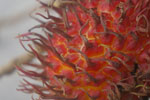Coffee may be one of the world’s most popular hot (and cold) drinks, however few coffee drinkers may know that there are dozens of different coffee species in the world and some are even endangered. Only discovered in 2004, Kihansi coffee (Coffea kihansiensis), makes its home in the Udzungwa Mountains of Tanzania. A new study in mongabay.com’s open-access journal Tropical Conservation Science finds that the Kihansi coffee is nearing extinction due in part to a hydroelectric dam built upstream that has severely impacted the Kihansi River.
“Increasing evidence indicates that a range of animal and plant taxa, and the gorge ecosystem in general, have been severely disrupted by diversion of the river. The after-effects include changes in community composition and structure of birds, insects, and plants in the gorge wetlands,” the authors of the paper write. Already, the dam has pushed the Kihansi spray toad (Nectophrynoides asperginis) to extinction—although fortunately the species still survives in captivity—but now researchers fear it will do the same to Kihansi coffee, which is listed as Critically Endangered by the IUCN Red List.
The new study finds that less moisture from the river has impacted plant growth, essentially stalling growth at a particular height. In addition half of the plants surveyed showed evidence of parasites. In light of these threats the authors recommend ongoing monitoring of the population, additional research, identification of the plant’s seed dispersers, establishing a new population, and growing the species in a seed bank.
The authors argue that Kihansi coffee “could potentially be useful as a genetic resource to improve coffee production, for instance by incorporating disease resistant strains from other species, thus contributing greatly to improved coffee production in rural communities.”
CITATION: Rija, A. A., Mwamende, K. A. and Hassan, S. N.. 2011. The aftermath of environmental disturbance on the critically endangered Coffea kihansiensis in the Southern Udzungwa Mountains, Tanzania. Tropical Conservation Science Vol. 4(3):359-372.
Related articles

(08/01/2011) Among conservationists and biologists, the mega-island of Borneo is a sort of Mecca. Its rich plant and animal biodiversity, as well as high degree of endemism (unique species found nowhere else) make it a naturalist’s dream. There is one aspect of this biological richness which applies to the wellbeing and happiness of all of Borneo’s residents, human and animal, in a very direct way: fruit. From wild forest berries to juicy cultivated rambutans, fruit permeates the ecology, landscape and culture of Borneo. On the island there are over 70 wild fruit trees species and around 45 cultivated species that are consumed by people (1). Science has certainly not yet documented all the fruit consumed by wildlife, but we know that the total must be over 500 species.
‘Luck and perseverance’: new plant genus discovered in Amazon
(03/31/2011) The discovery of a new plant species is not uncommon, especially in places of remarkable biodiversity such as the Amazon rainforest. However, discovering a new plant genus, a taxonomic rank above species, is, according to Henk van der Werff fromt the Missouri Botanical Garden (MBG), “a matter of luck and perseverance”. Researchers with the Missouri Botanical Garden have been blessed with both as they have announced two new species of Amazonian plants, one from Ecuador and one from Peru, that comprise a completely new genus: named, Yasunia, since the plant was originally discovered in Ecuador’s vast Yasuni National Park.
‘Huge reduction’ of water from plants due to higher carbon levels
(03/30/2011) As if ocean acidification and a warming world weren’t enough, researchers have outlined another way in which carbon emissions are impacting the planet. A new study shows that higher carbon dioxide levels in the atmosphere have taken a toll on how much water vapor plants release, potentially impacting the rainfall and groundwater sources. A study in the Proceedings of the National Academy of Sciences (PNAS) has found that carbon dioxide levels over the past 150 years has reduced plants’ spores, called stomata, by over one third (34%). This is important because stomata take in oxygen and carbon dioxide and release water vapor in a process dubbed ‘transpiration’. Less stomata means less water driven into the atmosphere.







